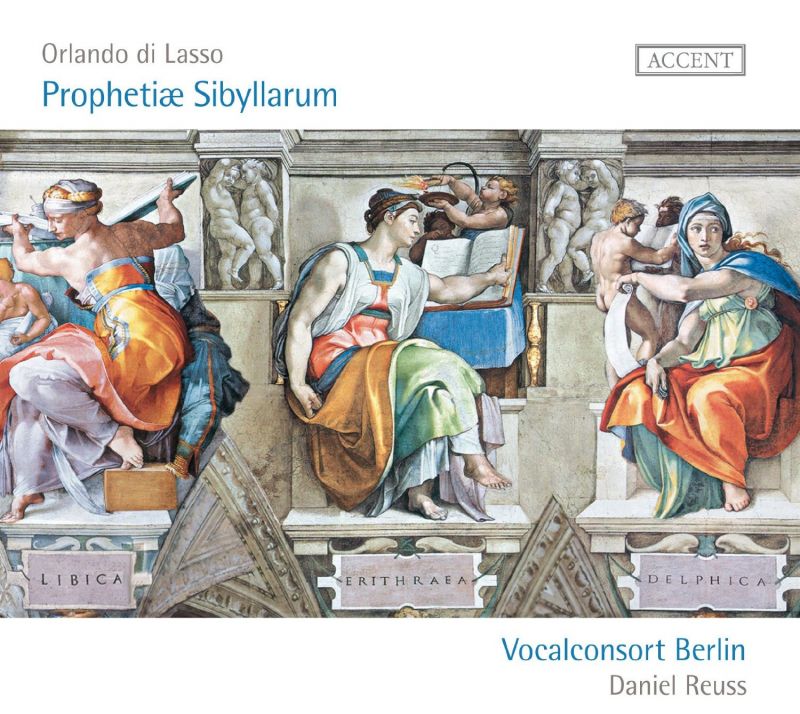LASSUS Prophetiae sybillarum
View record and artist detailsRecord and Artist Details
Composer or Director: Orlande de Lassus
Genre:
Vocal
Label: Accent
Magazine Review Date: 11/2015
Media Format: CD or Download
Media Runtime: 49
Mastering:
DDD
Catalogue Number: ACC24307

Tracks:
| Composition | Artist Credit |
|---|---|
| Prophetiae Sibyllarum |
Orlande de Lassus, Composer
Berlin Vocal Consort Daniel Reuss, Conductor Orlande de Lassus, Composer |
| Angelus ad pastores iat |
Orlande de Lassus, Composer
Berlin Vocal Consort Daniel Reuss, Conductor Orlande de Lassus, Composer |
| Ave Maria gratia plena |
Orlande de Lassus, Composer
Berlin Vocal Consort Daniel Reuss, Conductor Orlande de Lassus, Composer |
| Dixit Dominus |
Orlande de Lassus, Composer
Berlin Vocal Consort Daniel Reuss, Conductor Orlande de Lassus, Composer |
| Magnificat superaurora lucis rutilat |
Orlande de Lassus, Composer
Berlin Vocal Consort Daniel Reuss, Conductor Orlande de Lassus, Composer |
| Quem vidistis pastores |
Orlande de Lassus, Composer
Berlin Vocal Consort Daniel Reuss, Conductor Orlande de Lassus, Composer |
| Videntes stellam |
Orlande de Lassus, Composer
Berlin Vocal Consort Daniel Reuss, Conductor Orlande de Lassus, Composer |
Author: Fabrice Fitch
Vocalconsort Berlin’s approach is most comparable to The Brabant Ensemble’s for Hyperion, though the deeper acoustic imparts a ‘bigger’ sound. From a choral and technical perspective they may well offer the most rounded and vocally satisfying of the available alternatives. Both here and in the motets that complete the recital, Daniel Reuss’s direction tends towards smooth lines and seamless transitions, an approach that obviously corresponds to the ensemble’s sound but does little to bring out the essential strangeness of the Prophetiae. It’s not just a matter of those chromatic turns: there are sudden leaps, shifts of register, wide gaps in the texture (especially below the top voice) and the obsessive repetition of certain words. Likewise, the frequent syllabic word-setting is highly suggestive of declamation, whereas the general dynamic never rises above mezzo-forte. Perhaps the deliberately subdued tone is meant to impart a dream-like quality, but to my mind it misses the rhetorical edge that Lassus’s bold gestures seem calculated to convey. As an introduction to a sybilline, not to say sphinx-like work, this may be the best we’ve got, but the search for a fully realised interpretation goes on. The accompanying motets are a rather piecemeal selection where several rival recordings of the Prophetiae offer something more substantial for their ‘B-sides’. At under 50 minutes, it’s also a thin serving of repertoire that’s not in copyright.
Discover the world's largest classical music catalogue with Presto Music.

Gramophone Digital Club
- Digital Edition
- Digital Archive
- Reviews Database
- Full website access
From £8.75 / month
Subscribe
Gramophone Full Club
- Print Edition
- Digital Edition
- Digital Archive
- Reviews Database
- Full website access
From £11.00 / month
Subscribe
If you are a library, university or other organisation that would be interested in an institutional subscription to Gramophone please click here for further information.




